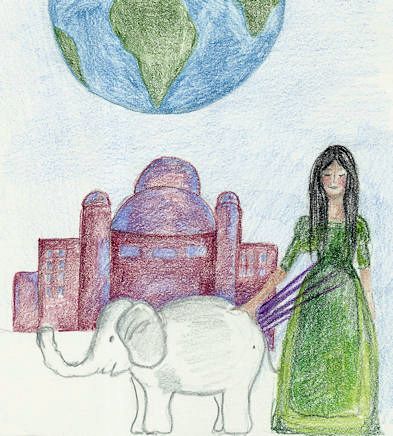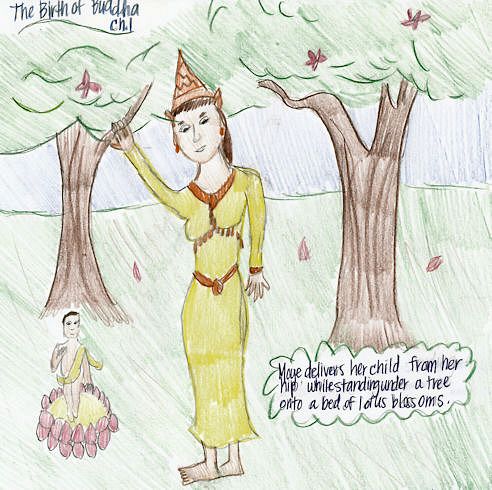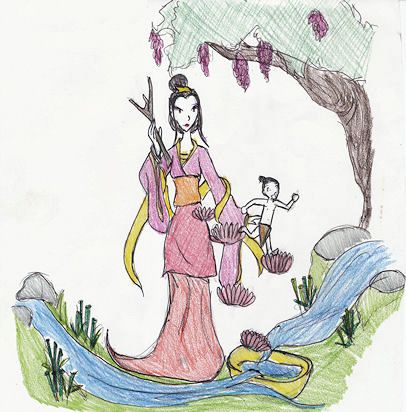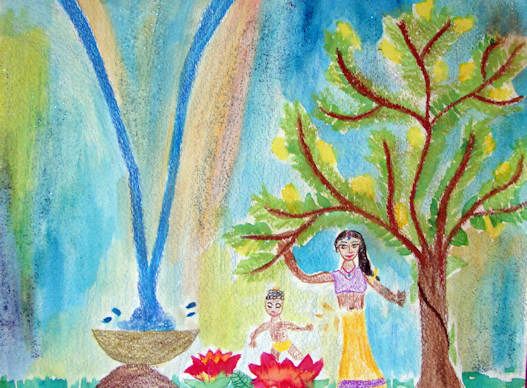
Queen Móyé dreamt that she was carried by a cloud into a great palace in the sky.
Drawing by Jaclyn Allavie, Eleanor Roosevelt College (UCSD), Class of 2009, by permission

This is the story of the historical buddha (fótuó 佛陀), the one we today call Shìjiā-móuní 释迦牟尼. He was probably born somewhere between 566 and 430 BC. Shìjiā-móuní lived in India, which was called Zhānbù-zhōu 瞻部洲 at the time, and was divided into a great many tiny states run as kingdoms or as loose alliances of tribal territories.
One of these states was called Jiāpí-luó 迦毘罗, which was located along the northern bank of the Nuódí 那笛 River at the foot of the Himalayas. It was destroyed in the lifetime of the Buddha, but it is thought to have been located about a little to the north-west of present city of Gorakhpur near the Indian border with Nepal.
Jiāpí-luó was ruled over by a king of the Shìjiā 释迦 clan (zú 族) with the priestly surnames Qiáo-dámó 乔答摩 and Qūtán 瞿昙 and the given name Jìngfàn 净饭. He was therefore called King Jìngfàn.
His wife was named Móyé 摩耶, which means "illusion." Although the two had been married for a time, Queen Móyé remained a virgin. But an angel looked down upon the earth and saw that it was full of suffering, and knew that it was time to send a child who could teach people the way to avoid suffering.

Therefore one day Queen Móyé dreamt that she was carried by a cloud into a great palace in the sky, where a white elephant magically entered her side.
Some time after this odd dream, she realized that she had become pregnant. When she had been pregnant for ten months and it was time to give birth, she received the king's consent to return to her native town for the delivery. That town was called Tiānbì 天臂, and it was ruled over by her father, King Shànjué 善觉.

On the border where the territory of Jiāpí-luó adjoined the territory of Tiānbì there was a beautiful area called the Lán-píní 蓝毘尼 Garden (yuán 园), about 15 miles from Jiāpí-luó, where people from both realms yearly joined in spring celebrations beneath a giant teak (wúyōu 无忧) tree.
When Móyé reached the garden, she stopped to rest. Some say it was the 5th day of the week on the 15th day of the 6th month of the year by the local calendar, others the 8th day of the fourth month. It is celebrated on China as the 5th lunar month. [The year is unclear. Some scholars say 563 BC, but Buddhist tradition places it earlier, and some evidence suggests a date of about 500 BC.]

It was here that she delivered her child. And it is said that she delivered him while standing under the tree holding a branch with her right hand, and that he was born from her hip onto a bed of lotus blossoms. And it is said that two streams of water poured down to the earth into a golden basin that arose from the ground so that the newborn child could bebathed.
He already had the form of a small child, and could already walk, and he knew of his earlier incarnations upon this earth. He walked for seven steps, leaving seven lotus prints where he stepped. He could already speak several languages and had the voice of a lion. He declared that he would find salvation.
Far away to the southeast, near modern Gaya in northern India, there was a forest of papaya trees, called the Papaya Forest (Mùguā Lín木瓜林), which was also called the Forest of Mortification (Kǔxíng Lín 苦行林) because ascetics practiced austerities there.

He walked for seven steps, leaving seven lotus prints where he stepped.
Drawing by Sara Buchner, Sixth College (UCSD), Class of 2010, by permission
At the moment of the Buddha's birth, a fig (pútí 菩提) tree suddenly sprouted in the Forest of Mortification. The fig tree was destined to shelter the Buddha when he attained enlightenment.
Queen Móyé and the little prince (tàizǐ 太子), then slowly made their way back to Jiāpí-luó, where the king received the news of his son's birth with great delight. Because he was born of the Shìjiā clan, the Buddha is usually called Shìjiā-móuní 释迦牟尼, which means the sage of the Shìjiā clan.
(There were buddhas before him and others will follow. The buddha immediately before Shìjiā-móuní is referred to as the "Lamplighter Buddha" or Rándēng-fó 燃灯佛 because he brought light to the world, and the buddha who is next to come is the "Mílè Buddha" or Mílè-fó 弥勒佛. Some people like to pretend that Mílè-fó is already among us or has already come and gone, but that is not the prevailing view.)